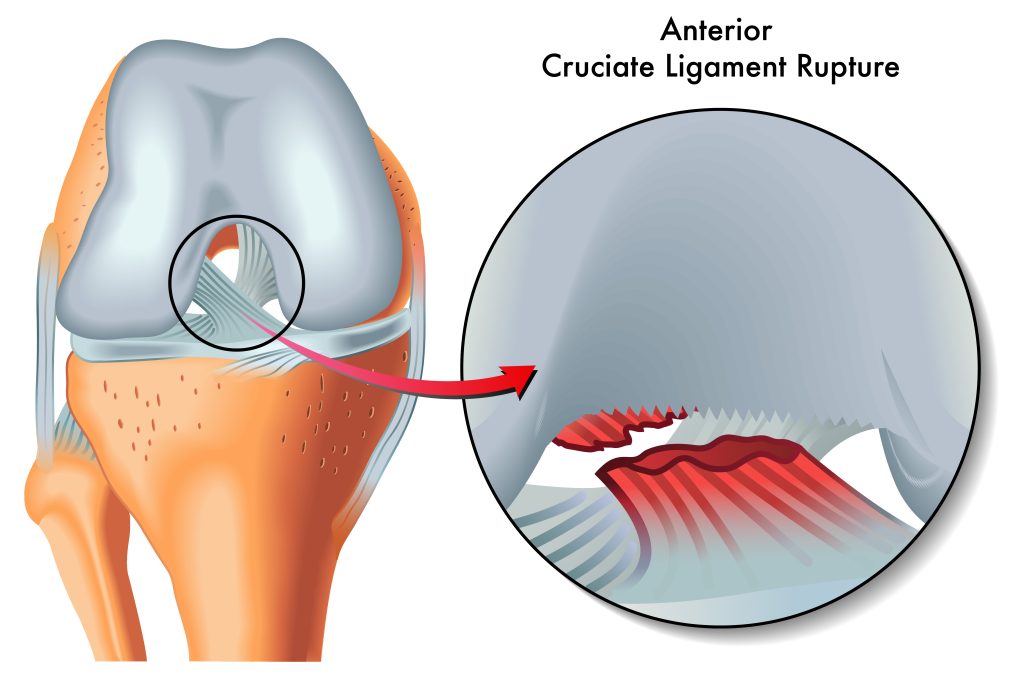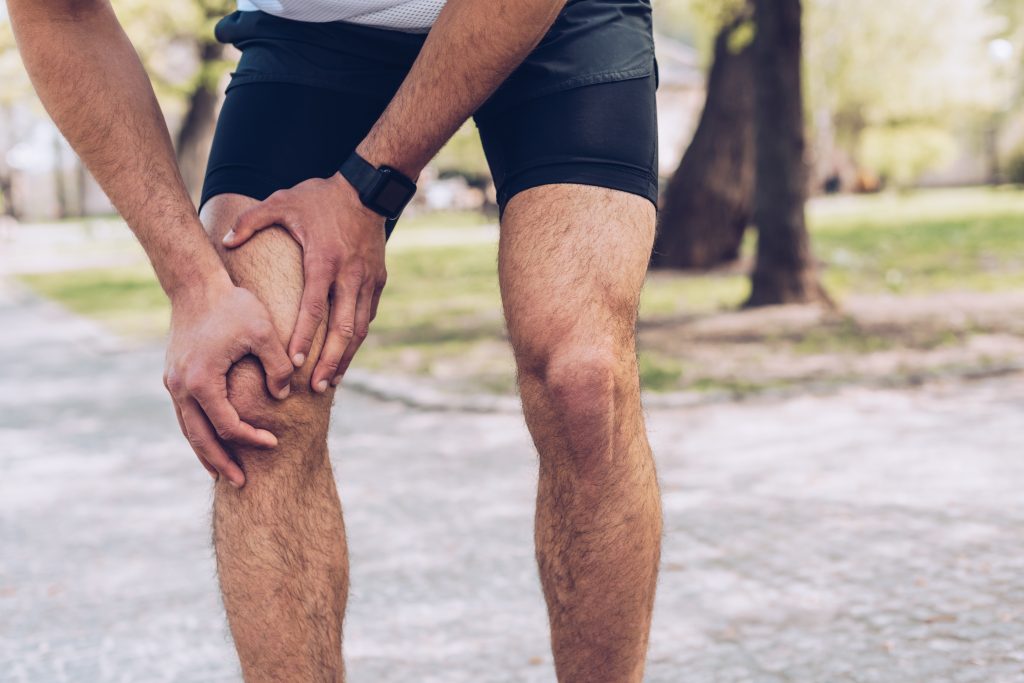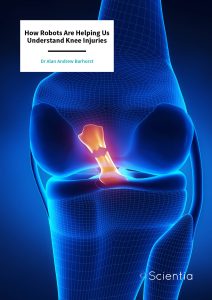Dr Alan Barhorst | How Robots Are Helping Us Understand Knee Injuries
Knee injuries can be notoriously complex. In recent years, many studies have attempted to investigate a potential link between the geometry of the knee and the risk of injury to a ligament called the ACL (anterior cruciate ligament). Dr Alan Barhorst from the University of Lousiana at Lafayette, alongside colleague Mr Ross Wilson, enlisted the help of two robots to perform a biomechanical study of this phenomenon. Their findings provide valuable insight into our vulnerability to ACL injuries.
The Problem with Knee Injuries
In our bodies, the ACL – known in full as the anterior cruciate ligament – provides a thick sheath of connective tissue that not only stabilises our knee but prevents our shinbone (tibia) from sliding in front of our thighbone (femur).
The ACL is a crucial area of study for several reasons. First, the American Board of Orthopaedic Surgeons reports ACL surgery to be one of the most common orthopaedic (bone or muscle) surgeries performed worldwide. Second, ACL injuries are very common in sports that involve a lot of force (e.g., jumping, contact, rapid acceleration and pivot movements). While the posterior, medial and lateral cruciate ligaments also work hard to support the knee, they can usually be rehabilitated with non-surgical treatments such as physiotherapy.
However, if you’ve ever skied, played rugby, or football, run, or are generally very active, you might have experienced ACL pain. That’s because the ACL plays a vital role in supporting and stabilising the knee in all activities, and when subjected to more stress or force than it is able to handle, it becomes injured. And that’s a problem because ACL injuries often require surgery. Dr Alan Barhorst from the University of Louisiana at Lafayette and his colleague, Mr Ross Wilson, are working to better understand how and why such injuries occur in the first place.

Taking it up a Notch
More specifically, Dr Barhorst and Mr Wilson wanted to know if a smaller-sized intercondylar notch might make us more likely to suffer from injuries to our ACL.
But what exactly is an intercondylar notch? It is called ‘intercondylar’ because it is a deep space that sits between (inter) the two condyles (or rounded ends) of our thighbone (where the thighbone attaches to the knee). It stabilises the knee and also provides the attachment site for the ACL and posterior cruciate ligaments. These ligaments play a vital role in connecting our thighbone to our shinbone.
Dr Barhorst and Mr Wilson looked specifically at whether having a smaller intercondylar notch would be more likely to cause a lateral impingement (causing a transverse load) of the ACL, and whether any observed impingement could be a cause of injury to the ACL.
The Robots Begin
To explore this question, the researchers utilised two robotic manipulators. These robots directed the knee joints of multiple cadavers (corpses), in order to simulate a range of complex biomechanical movements. The use of a two-robot system was necessary because it allowed observation of how the femur and tibia work together across a vast range of movements.
The three female and three male cadavers used were non-osteoarthritic (i.e., without arthritis), and under the age of seventy years. Biomechanical testing allowed Dr Barhorst and Mr Wilson to observe the rate of impingement in these knees, and to also observe if these impingements caused injuries. The experimental data pointed to impingements in five out of the six cadaver knees but these impingements were not a cause of injuries. This suggests that such impingements may actually be a regular and normal occurrence in healthy knees.

Male and Female Differences
Interestingly, a lower elasticity was reported in the ACL of women. That could potentially mean a lower ability to withstand force and a greater potential for injury of the ACL. Dr Barhorst and Mr Wilson also observed impingement to be more frequent in females, who also exhibited smaller intercondylar notch sizes.
Future Directions and Clinical Implications
Dr Barhorst and Mr Wilson have extended our understanding of ACL injury, providing valuable experimental data. They recommended the use of larger sample sizes, continued testing and 3D anatomical measurements in future studies. Their work ultimately contributes to a fascinating field that helps us to understand, treat, and prevent, knee injuries far more effectively. And this is great news for all of the sports people and fitness fans out there who love to stay active but injury free.
SHARE
DOWNLOAD E-BOOK
REFERENCE
https://doi.org/10.33548/SCIENTIA892
MEET THE RESEARCHER

Dr Alan Andrew Barhorst
Department of Mechanical Engineering
University of Louisiana at Lafayette
Lafayette, LA
USA
Dr Barhorst graduated from Texas A&M University in 1984 and 1989 respectively, with a BS degree and then an MS degree in Mechanical Engineering. Dr Barhost went on to complete his studies at his alma mater, being awarded a PhD in Mechanical Engineering in 1991. He is currently Professor and Head of the Mechanical Engineering Department, Alumni Association & LEQSF (Louisiana Education Quality Support Fund) at the University of Louisiana at Lafayette. In addition, Dr Barhost is the inaugural co-editor of the Springer academic journal Data Enabled Discovery and Applications. Elected a Fellow of the American Society of Mechanical Engineers in 2013, Dr Barhost was later awarded a J. Tinsley Oden Faculty Fellowship at the University of Texas at Austin in 2016. His research interests include biomechanics, control system design, dynamics, design, fluid-structure interaction and healthcare engineering.
CONTACT
E: alan.barhorst@louisiana.edu
KEY COLLABORATORS
Mr Ross Wilson, Texas Tech University, TX, USA
FUNDING
Texas Tech University College of Engineering Grant
FURTHER READING
R Wilson, AA Barhorst, Intercondylar Notch Impingement of the Anterior Cruciate Ligament: A Cadaveric In Vitro Study Using Robots, Journal of Healthcare Engineering, 2018, 8698167. DOI: http://doi.org/10.1155/2018/8698167

REPUBLISH OUR ARTICLES
We encourage all formats of sharing and republishing of our articles. Whether you want to host on your website, publication or blog, we welcome this. Find out more
Creative Commons Licence (CC BY 4.0)
This work is licensed under a Creative Commons Attribution 4.0 International License. 
What does this mean?
Share: You can copy and redistribute the material in any medium or format
Adapt: You can change, and build upon the material for any purpose, even commercially.
Credit: You must give appropriate credit, provide a link to the license, and indicate if changes were made.
SUBSCRIBE NOW
Follow Us
MORE ARTICLES YOU MAY LIKE
Dr Ralf Adam | New Technologies Shaping the Future of Oral Hygiene
Understanding the efficiency of various toothbrush technologies is essential for achieving optimal oral health. Dr Ralf Adam, who leads a dedicated team at Procter & Gamble in Germany, is keen to investigate the complexities of these technologies. His team have provided new insights into the best toothbrush types for plaque removal and the maintenance of gum health. By highlighting the importance of informed oral care decisions and ongoing investigations, this vital research works towards ensuring everyone can achieve a brighter, healthier smile.
Dr Toby Phesse | Revealing the Mysteries of Wnt Signalling: Novel Approaches to Beating Cancer
Cancer remains a leading cause of mortality worldwide, and the need for new, more effective treatments remains an urgent challenge. Dr Toby Phesse from Cardiff University in the UK focuses on the role of the Wnt receptor found on the surface of cells and its involvement with cell communication and cancer growth, bringing fresh hopes for new therapeutic options.
Dr Vijay Reddy | The Virus World Database: An Invaluable Resource for Public Health and Healthcare
Severe viral disease presents an ongoing challenge to the health of humankind. While unparalleled developments in science and technology are improving our understanding of such viruses, this information needs to be readily accessible to researchers to ensure continued progress in public health and healthcare. Dr Vijay Reddy and his colleagues at the Hormel Institute (University of Minnesota) developed the Virus World database, an invaluable resource that details the genome, structure, and host of practically every discovered virus to date.
Professor Ralf Herwig | Deciphering the Enigma of Vitamin D and the Immune System
Vitamin D has been studied as a treatment for a large number of diseases and conditions, from cancer to autism to COVID-19. However, its mode of action is not completely understood. Professor Ralf Herwig carries out his research at HG Pharma GmbH (Austria) and Ulster University (UK). His vital work explores the role of vitamin D in the body with a view to unlocking its potential as a treatment for a variety of health conditions involving the immune system.





